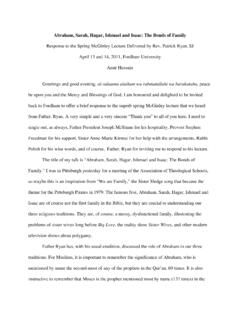Transcription of Fair Housing and Zoning Laws - Learn Law. Live Justice.
1 fair Housing and Zoning laws Edward G. Kramer Director & Chief Counsel THE Housing ADOVCATES, INC. 3214 Prospect Avenue Cleveland, Ohio 44115 (216) 431-5300 Fax (216) 431-6149 E-Mail kramere7@ Check out our website at: 2011 fair Housing & Zoning Workshop September 21 from 6 to 8 PM. The Department of Planning Services is presenting this workshop 1 | Page fair Housing Acts, Group Homes & Zoning Laws1 Generally, Ohio courts seem to include group homes in Zoning laws definitions of family and household.
2 See Westerville v. Kuehnert, 50 Ohio App. 3d 77 (Ohio Ct. App., 10th Dist. 1988) (licensed group homes for four developmentally disabled residents fell under the local Zoning ordinance s definition of household as permitted in its residential district); Freedom township Bd. Of Zoning Appeals v. Portage County Bd. Of Mental Retardation & In recent decade s treatment and Housing for Ohio s disabled citizens shifted from Housing in impersonal institutions to more personal and focused care in residential group homes.
3 Caretakers and the state legislature have recognized that patients enjoy extensive benefits from smaller, more normalized residential settings. As caretakers began to relocate patients from institutional districts to neighborhoods, they ran into opposition from local communities. These communities acted most likely on entrenched prejudices against individuals with disabilities, stemming from centuries of myths and miscommunications on their capabilities and the dangers they pose to others. See generally Epicenter of Steubenville v.
4 City of Steubenville, 924 F. Supp. 845 ( Dist., Ohio 1996); Ardmore v. City of Akron, 1990 Dist. LEXIS 20806 (D. Ohio, 1990). In response, communities began to pass Zoning laws that excluded group homes for the disabled from residential neighborhoods. The Ohio and Federal fair Housing Acts, ORC and 42 3601 et seq. (FHA), Ohio statutes allowing group homes in family districts, and general principles of equality and fairness, those wishing to establish residential group homes have fought back.
5 1 Part of this material is taken from a student memorandum done by Jessica Paine for the fair Housing Law Clinic entitled Ohio Case Law on Conflicts Between Group Homes and Exclusionary Zoning laws 2 | Page Developmental Disabilities, 16 Ohio App. 3d 387 (Ohio Ct. App., 11th Dist. 1984) ( The fact that the occupants of a group home will operate as a unit for purposes of cooking, cleaning and otherwise maintaining the home is reliable, probative evidence that the home's occupants will function as a family unit.)
6 ; Herr v. Morris Constr. Co., 1983 Ohio App. LEXIS 11223 (Ohio Ct. App., 1983) (group home for six mentally retarded women qualified as family ); Fliotsos v. Youngstown, 1983 Ohio App. LEXIS 14149 (Ohio Ct. App., 1983) (court found that home of plaintiff who wished to raise five mentally retarded children with the help of paid assistants qualified as family home under broad definition of family required by case law); see contra White v. Bd. Of Zoning Appeals, 1982 Ohio App. LEXIS 13776 (Ohio Ct. App., 5th Dist.)
7 , 1982), discussed infra. However, it is extremely important to remember that such findings depend on the individual Zoning law s definition of family or household. At least one Ohio court has held that in the absence of any definition of the word family or household as used in restrictions for single family or single household districts, group homes are more closely allied with family use than commercial use. In Freedom township , 16 Ohio App. 3d 387, the court held that the local mental retardation board s proposed use of a house located in a residential district as a group home for mentally retarded adults was a permitted use.
8 In the absence of any definition of family, the court looked to the ordinary meaning of family use as opposed to commercial use. Id., 390. The court found that because of the restriction of property rights inherent in Zoning laws , any ambiguity must be construed against the restrictions. Id. The court held that, in light of earlier case law in the area, the fact that the residents operate a unit for purposes of cooking, cleaning and otherwise conducting everyday chores is probative evidence of their domestic cohesiveness.
9 Id., 391. Thus, when 3 | Page Zoning ordinances are silent on the definition of family or household, there is some authority that the extent of their communal activities qualifies group homes as families. If the Zoning law defines family or household only as a certain number of persons living as a single dwelling or housekeeping unit with no restrictions on relation by blood or marriage, Ohio courts tend to include group homes within the ordinance s definition. See Westerville, 50 Ohio App. 3d 77 ( ordinance limited number of unrelated individuals still classified as a family to five 2 The fair Housing Act ( FHA ), passed by Congress as Title VIII of the Civil Rights Act Herr, 1983 Ohio App.)
10 LEXIS 11223; Beres, 6 Ohio App. 3d 71; and Fliotsos, 1983 Ohio App. LEXIS 14149. Zoning laws are highly individualistic, and the courts results frequently turn upon the inclusion of a single term that separates a particular ordinance from other municipalities language. From the limited extent of Ohio jurisprudence on the subject, a careful observer may nevertheless draw several conclusions. FEDERAL fair Housing ACT AND LOCAL LAND USE ORDINANCES 2 As of the date of this writing, the author was unable to find any Ohio case law determining the legality of limits on numbers of unrelated individuals living together higher than two but fewer than restrictions placed on related persons, other than White v.












